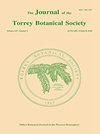Floral Ontogeny of Salpiglossis (Solanaceae) and the Oblique Gynoecium
IF 0.8
4区 生物学
Q4 PLANT SCIENCES
引用次数: 5
Abstract
AMPORNPAN, L. AND J. E. ARMSTRONG. (Faculty of Science, Srinakharinwirot University, Bangkok, Thailand, and Campus Box 4120-Biological Sciences, Illinois State University, Normal, IL 61790-4120). Floral ontogeny of Salpiglossis (Solanaceae) and the oblique gynoecium. J. Torrey Bot. Soc. 129:85-95, 2002.-Inflorescence development in Salpiglossis consists of repeated modular units consisting of two floral bracts on an axis terminating in a flower. The calyx is initiated in a helix with the first primordium appearing on the abaxial side of the floral apex. Primordia of the corolla, androecium, and gynoecium arise in three successive whorls. Zygomorphy first becomes manifest with the slightly delayed initiation of a staminodial primordium. Growth of the corolla and androecium show a dorso-ventral asymmetry that also results in zygomorphy. During early development the median plane of many flowers is on the axillary plane. The median plane of other flowers is oriented 10-15? off the axillary plane, but this is less than half the expected 36?. The off-median orientation does not produce the oblique gynoecial orientation described in the literature as a defining feature of Solanaceae. The zygomorphic flowers of Salpiglossis have a gynoecium that is on the median plane and not oblique. Further the flowers are not obliquely oriented unless via pedicel rotation prior to anthesis. The floral orientation of Solanaceae, as exemplified by Salpiglossis, has the staminode and a calyx lobe in the abaxial position, which is a synapomorphy with respect to other Asteridae.茄科茄属植物的花体发育与斜向雌蕊
阿姆庞潘,l.和j. e.阿姆斯特朗。(泰国曼谷斯利那卡林威罗大学理学院,伊利诺伊州立大学生物科学校区4120,伊利诺伊州立大学师范学院,IL 61790-4120)。茄科茄属植物的花体发育与斜向雌蕊。托里·博特。《社会科学》(英文版),2002。- Salpiglossis的花序发育由重复的模块单元组成,包括在轴上终止于一朵花的两个花苞片。花萼形成螺旋状,第一个原基出现在花端背面。花冠原基、雄蕊和雌蕊在三个连续的轮生中出现。随着雄蕊原基产生的稍微延迟,颧畸形首先变得明显。花冠和雄蕊的生长表现为背腹不对称,这也导致了颧骨畸形。在早期发育期间,许多花的中平面在腋生平面上。其他花的中平面朝向10-15?在腋窝平面外,但这还不到预期的一半。离中位取向不会产生斜雌蕊取向,在文献中描述为茄科的一个定义特征。Salpiglossis的颧形花有雌蕊,雌蕊位于中平面而不斜。此外,除非花梗在花前旋转,否则花不斜向定向。茄科植物的花型与其他菊科植物相比,雄蕊和花萼裂片位于背面,如茄科植物Salpiglossis。
本文章由计算机程序翻译,如有差异,请以英文原文为准。
求助全文
约1分钟内获得全文
求助全文
来源期刊
CiteScore
0.70
自引率
0.00%
发文量
16
审稿时长
>12 weeks
期刊介绍:
The Journal of the Torrey Botanical Society (until 1997 the Bulletin of the Torrey Botanical Club), the oldest botanical journal in the Americas, has as its primary goal the dissemination of scientific knowledge about plants (including thallopyhtes and fungi). It publishes basic research in all areas of plant biology, except horticulture, with an emphasis on research done in, and about plants of, the Western Hemisphere.

 求助内容:
求助内容: 应助结果提醒方式:
应助结果提醒方式:


